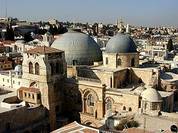Lectio Divina: A Popular Revival Underway
Our Holy Father has recently urged Catholics to renew an ancient practice in the Church, namely to initiate the regular devotional practice of lectio divina.
In lectio divina the Scriptures are opened up to their interior or hidden meaning by the action of the Holy Spirit, as our spirit is lifted up from earth to heaven to "touch heavenly secrets." This occurs through a four stage process that includes reading, meditation, prayer and contemplation. As Guigo II, ninth abbot of the Grand Chartreuse, writing in the twelfth century described it concisely:
Our Holy Father has recently urged Catholics to renew an ancient practice in the Church, namely to initiate the regular devotional practice of lectio divina.
In lectio divina the Scriptures are opened up to their interior or hidden meaning by the action of the Holy Spirit, as our spirit is lifted up from earth to heaven to "touch heavenly secrets." This occurs through a four stage process that includes reading, meditation, prayer and contemplation. As Guigo II, ninth abbot of the Grand Chartreuse, writing in the twelfth century described it concisely:

Reading is the careful study of the Scriptures, concentrating all one's powers on it. Meditation is the busy application of the mind to seek with the help of one's reason for knowledge of hidden truth. Prayer is the heart's devoted turning to God to drive away evil and obtain what is good. Contemplation is when the mind [i.e., spirit] is in some sort lifted up to God and held above itself, so that it tastes the joys of everlasting sweetness.
This ancient practice is also a form of deep prayer, because each of its four dimensions are infused with prayer. The goal is union with God through Jesus in the Holy Spirit. In the first dimension, which is lectio or reading, one prays (e.g., for the intercession of the Blessed Mother and Saints), before reading the Scriptures and in a real sense, God speaks to us as we read his word. Remember he words of Psalm 119, "How sweet are your words to my taste, sweeter than honey to my mouth! Through your precepts I get understanding, therefore I hate every false way. Your word is a lamp to my feet and a light to my path."
During the meditatio or meditation, the prayer is for divine assistance and may involve "an inner conversation with the Lord." The third dimension is oratio or prayer itself, in which the Holy Spirit is active as in the reading, when it is done "in the Spirit." The fourth dimension, contemplatio or contemplation, when it occurs, breaks into personal prayer and lifts the soul up so that, in a real sense, it is a response to prayer by God. This prayer, as with all authentic prayer, is designed to lift our hearts and minds to God, "to behold the beauty of the Lord," as Psalm 27 puts it. These four dimensions were frequently compared to the rungs of a ladder, used to draw closer to God.
The Fathers of the Church viewed the Holy Scriptures as containing the bounty of the forest or the vastness of the sea. Through its study and lectio divina they sought to be formed in the Word of God by Christ, who's Holy Spirit inspired the Scriptures, in which Christ is found in a genuine encounter of communion. In lectio divina we listen to the Biblical sense in the literal sense, but the Fathers of the Church, who are reliable guides, teach us not to get bogged down in the narrative alone, since the depth of meaning in Scripture is understood only when we read "in the Spirit." St. Gregory the Great wants us to understand that there are two levels, namely, the enunciated text itself and the "mystery" which goes beyond the text (i.e., literal and spiritual senses). Thus, the Bible simultaneously expounds the text and enunciates a mystery.
The faithful must approach the Word of God with "devout humility" and with love for this sacred gift to us. St. Augustine says, "The most important thing is to pray for understanding." Lectio divina prepares you for the liturgy. Here's a practical how to do it:
1) Choose a Scripture passage.
2) Quiet your heart and mind and invite the Holy Spirit to lead your time of prayer. Humbly ask God to reveal something of himself to you.
3) Read the text two or more times, finally, even word by word. Ponder those words or phrases.
4) Converse with the Lord about how the word, phrase or text is affecting you.
5) Compose prayers from the Scripture "praying them back" to the Lord as they shine a light on your life.
6) Be open to contemplation by your prayers and humility of spirit. Surrender your will to Christ as we pray in the Our Father, “your will be done.”
This ancient practice is also a form of deep prayer, because each of its four dimensions are infused with prayer. The goal is union with God through Jesus in the Holy Spirit. In the first dimension, which is lectio or reading, one prays (e.g., for the intercession of the Blessed Mother and Saints), before reading the Scriptures and in a real sense, God speaks to us as we read his word. Remember he words of Psalm 119, "How sweet are your words to my taste, sweeter than honey to my mouth! Through your precepts I get understanding, therefore I hate every false way. Your word is a lamp to my feet and a light to my path."
During the meditatio or meditation, the prayer is for divine assistance and may involve "an inner conversation with the Lord." The third dimension is oratio or prayer itself, in which the Holy Spirit is active as in the reading, when it is done "in the Spirit." The fourth dimension, contemplatio or contemplation, when it occurs, breaks into personal prayer and lifts the soul up so that, in a real sense, it is a response to prayer by God. This prayer, as with all authentic prayer, is designed to lift our hearts and minds to God, "to behold the beauty of the Lord," as Psalm 27 puts it. These four dimensions were frequently compared to the rungs of a ladder, used to draw closer to God.
The Fathers of the Church viewed the Holy Scriptures as containing the bounty of the forest or the vastness of the sea. Through its study and lectio divina they sought to be formed in the Word of God by Christ, who's Holy Spirit inspired the Scriptures, in which Christ is found in a genuine encounter of communion. In lectio divina we listen to the Biblical sense in the literal sense, but the Fathers of the Church, who are reliable guides, teach us not to get bogged down in the narrative alone, since the depth of meaning in Scripture is understood only when we read "in the Spirit." St. Gregory the Great wants us to understand that there are two levels, namely, the enunciated text itself and the "mystery" which goes beyond the text (i.e., literal and spiritual senses). Thus, the Bible simultaneously expounds the text and enunciates a mystery.
The faithful must approach the Word of God with "devout humility" and with love for this sacred gift to us. St. Augustine says, "The most important thing is to pray for understanding." Lectio divina prepares you for the liturgy. Here's a practical how to do it:
1) Choose a Scripture passage.
2) Quiet your heart and mind and invite the Holy Spirit to lead your time of prayer. Humbly ask God to reveal something of himself to you.
3) Read the text two or more times, finally, even word by word. Ponder those words or phrases.
4) Converse with the Lord about how the word, phrase or text is affecting you.
5) Compose prayers from the Scripture "praying them back" to the Lord as they shine a light on your life.
6) Be open to contemplation by your prayers and humility of spirit. Surrender your will to Christ as we pray in the Our Father, “your will be done.”
 RSS Feed
RSS Feed

